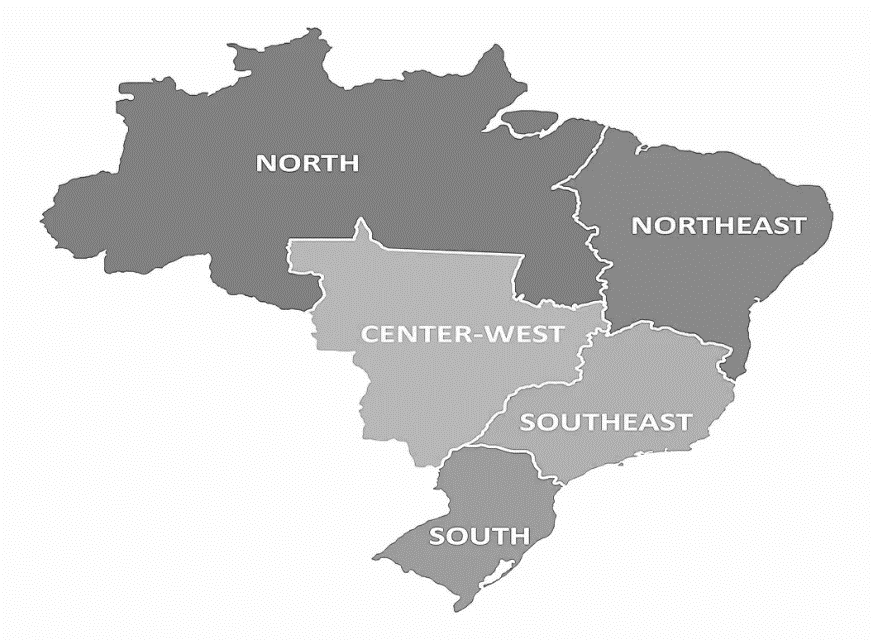Introduction
In Brazil, public Technical Assistance and Rural Extension services are aimed at serving land reform settlers, indigenous peoples, quilombola communities and other traditional communities, family farmers or rural family enterprises, foresters, aquaculturists, extractivists, and fishermen, as well as beneficiaries of colonization and irrigation programs (Presidência da República de Brasil, 2010). These target groups, as stipulated by law, often face economic constraints in terms of investment capacity in agricultural activities. This necessitates, at various historical and productive moments, the adaptation of low-cost technologies to enable their social and economic reproduction in rural areas. Social Technology, according to Dagnino (2014) and Passoni et al. (2004), is adapted to the limited physical and financial scale, capable of economically enabling self-managed enterprises through a set of transformative techniques and methodologies that promote social inclusion and improved living conditions. The most widespread social technologies in Brazil are biodigesters, agroforestry systems, seed banks, integrated and sustainable agroecological production and septic tanks. It also involves reusing materials available on properties, with simple methods, to facilitate the transformation and the social and productive impact of rural families, preferably, according to Carvalho and Lago (2020), with the potential for replication.
Despite the unfavorable political-economic context and the legislation governing extension services in the country, which limits the renewal of extension practices (Diniz & Hespanhol 2019), there is a consensus that social technologies can enable the quality of life of rural families, production for self-consumption, and the commercialization of surplus in small-scale agriculture. This research aims to contribute, theoretically, to the understanding of social technologies by rural extensionists in Brazil and to fill a gap in rural extension studies that propose to promote an ecological and agroecological-based approach using social technologies. However, there are still significant limitations in the training of extensionists to advance this process in the field. This article briefly describes the materials and methods used in research with rural extensionists. It then presents the results and discusses the perceptions of rural extensionists regarding social technologies. Finally, reflections and key findings of the research are summarized.
Materials and Methods
The research was carried out using a Google Forms questionnaire as a data collection instrument. The following categories of analysis were considered: perception of social technology. The questionnaire targeted professionals in Technical Assistance and Rural Extension (TARE) in Brazil, both from state and non-state entities. Emails were sent to all official state TARE institutions in Brazil, including central, regional, and local offices, provided they were listed on the TARE services websites. Emails were also sent to the Brazilian Association of State Entities of Technical Assistance and Rural Extension, as well as various NGOs, cooperatives, and private institutions that offer TARE services in Brazil. The questionnaire was available for completion between January 13, 2021, and April 13, 2021, and data were organized in Microsoft Excel spreadsheets and, after tabulation, they were exported to the Statistical Package for Social Science (SPSS) software version 20. Data mining techniques were used for parameterization to prepare all statistical analyses, including analysis of variance using the F-test to compare the means of each set of questions. Response proportions were compared using the chi-square and Fisher’s tests. Analysis of variance, frequency, and descriptive analyses were conducted using the MIXED, FREQ, and MEANS procedures in SPSS. Differences between means and proportions were considered significant at a probability level equal to or less than 5% (p <= 0.05). The multivariate analysis involved information from between and within the regions analyzed.
Brazil’s Regions
Brazil is a country (Figure 1) with continental dimensions, especially due to its extensive territorial area. There are different physical, human and cultural elements in the same geographical space, as well as a great deal of demographic, experiential and cognitive diversity. In the country, there are predominantly 5 073 324 establishments occupying 351 289 816 hectares, 85% of which reported not obtaining financing for production, according to data from the Agricultural Census (Instituto Brasileiro de Geografia e Estatística [IBGE], 2019). In the North of the country there is the Amazon rainforest with high biodiversity, with indigenous populations and riverside dwellers who contribute to cultural diversity, the focus of rural extension work. The Central-West region stands out for its Pantanal and the Central Plateau, with the prominence of agriculture as an economic activity, leading the country’s indicators with the highest effective number of cattle (IBGE, 2019). The Northeast region retains the vestiges of colonial production, with sugar cane, cocoa, cotton and tropical fruit, and has a diverse cultural heritage, with significant challenges for the economy and the population's way of life. The Cerrado and Caatinga biomes are also found in the Northeast. According to Nunes et al. (2015), the Northeast is the region with the most precarious rural, family-based agricultural economy. The Southeast has the country’s highest indicators of industrialization, with a rich culture of diverse ethnicities, as well as a strong presence in dairy farming, coffee, and agriculture. The biome called Atlantic rainforest is found in the Southeast, as well as a small stretch of Cerrado and Caatinga. The South has a subtropical climate and a diversified economy, with an emphasis on agriculture and industry, and we find the Pampas biome. The highest rates of technology use in Brazilian family farming are concentrated, in particular, in the states of the South and Southeast (Souza et al., 2023).
Results
A total of 575 responses were obtained from the research instrument. Based on their experience and conviction about social technologies, extensionists were asked to rate their level of agreement with numerous statements in three broad categories. Table 1 presents the results of extensionists’ opinions of social technologies with respect to advanced technological development. The results show that in the North (60.9%), Northeast (49.7%), and South (41.6%) regions, more extensionists agree with this statement (advanced technological products), followed by respondents from the Southeast and Central-West regions, with, 37.4%, and 32.5%, respectively. It should be noted that the North, Central-West, and Southeast regions showed a significant difference in the opinions (agree, disagree, and indifferent) of professionals regarding the advancement of social technologies. Technicians in the South and Northeast regions did not show differences between them in terms of responses of agree, disagree, and indifferent. Regarding extensionists among the regions who agree or are indifferent to the assertion that social technologies are advanced, a significant difference was found between the regions. The extensionists’ opinion on whether social technologies are competitive and advantageous or if they only promote economic growth, there was no significant difference within or between regions. In relation to increase productivity, the North region (66.3%) had the highest rate of respondents agreeing with the statement, on the other hand, extensionists in the Southeast and South regions were the ones with the highest indicators of indifference, with 48.5% and 43.5%, respectively, differing from extensionists in the Northern and Northeast regions. Within each region, only the Central-West and Southeast regions showed a statistical difference between responses. Regarding the statement that the application of social technologies means technology transfer, all regions except the South showed differences, with the majority of extensionists in the Central-West (61.7%), North (53.8%), and Northeast (46.5%) regions agreeing with this assertion. However, in the Southeast region, most extensionists were indifferent (45.8%). Among the regions of Brazil, the research highlighted differences. The highest rates of responses agreeing, disagreeing, or being indifferent to the assertion that the application of social technologies means technology transfer were found in the Central-West (61.7%), South (34.3%), and Southeast (45.8%) regions, respectively.
Table 1
Opinion of extension workers regarding the experience and conviction in the use of social technologies with respect to technological development
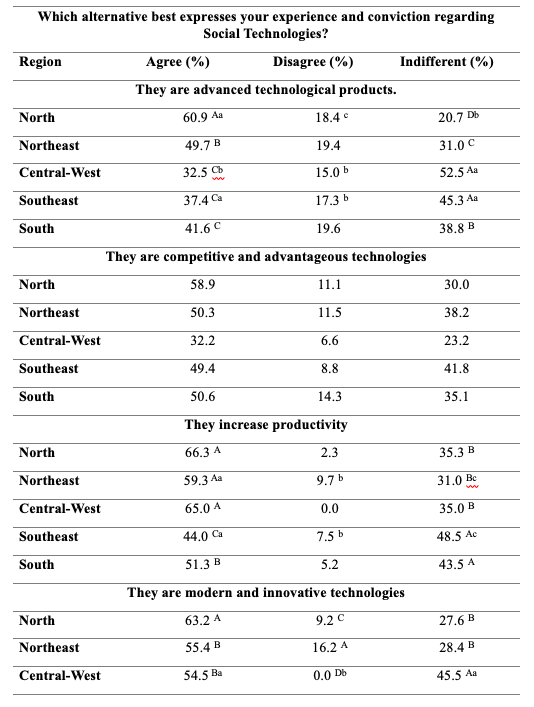
NoteLines with different lowercase letters differed significantly (p < 0.05); columns with different capital letters differed significantly (p < 0.05).
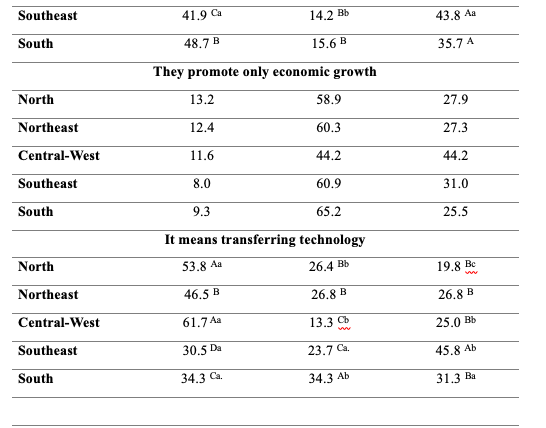
Source: Own elaboration.
The results in Table 2 show that when asked if the applied social technologies are simple, fast, and easy to implement, there was no significant difference within or between regions. It is noteworthy that the overall average of extensionists’ opinions on this statement was 27.5% disagree and 49.8% indifferent. When asked if social technologies are incompatible with agroecological systems, the only difference between regions in the country occurred in the “agree” response, with the Northern region having 15.1% of extensionists agreeing with this statement, distinguishing it from the others. Within regions, all of them showed differences in the percentage of extensionists who agreed, disagreed, and were indifferent to the statement that social technologies are incompatible with agroecological systems, with averages of 8.4%, 62.1%, and 29.6%, respectively.
Table 2
Opinion of extensionist workers regarding the experience and conviction in the use of social technologies about their applicability and effectiveness
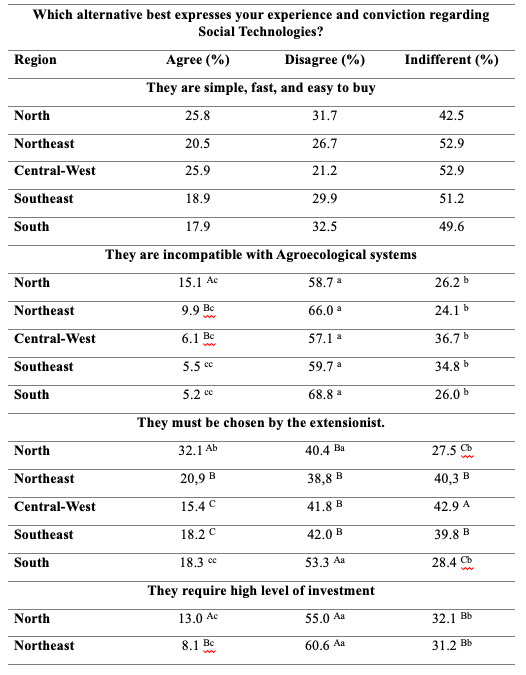
NoteLines with different lowercase letters differed significantly (p < 0.05); columns with different capital letters differed significantly (p < 0.05).
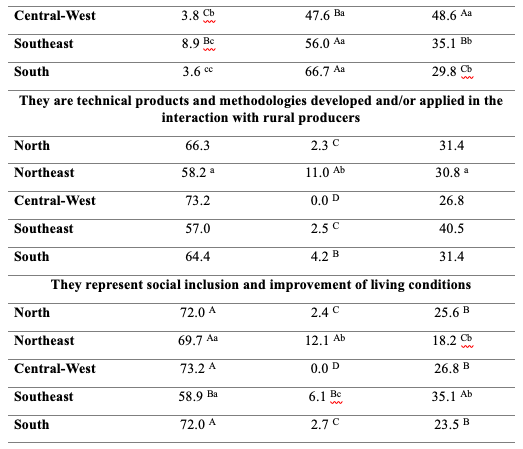
Source: Own elaboration.
About whether technical products and methodologies developed and/or applied are based on interaction with rural producers, only the “disagree” response to this statement showed a difference between the regions, with extensionists in the Northeast region having the highest value of around 11.0%. It is also noteworthy that the overall average of all extensionists in this study was only 4.0% who disagreed with the statement. In addition, only the Northeast region showed a significant difference between the “agree”, “disagree”, and “indifferent” responses. In relation to the statement that social technologies require a high level of investment, there was a difference between all responses (agree, disagree, and indifferent) when comparing regions. Extensionists from the North region (13.0%) were the ones who agreed the most with the statement, while respondents from the Central-West region had the lowest (47.6%) and highest (48.6%) rates of disagreement and indifference, respectively. Regarding the question of whether social technologies represent social inclusion and improvement of living conditions, all responses (agreeing, disagreeing, or indifferent) showed differences when comparing the regions. Looking at those who agree with the statement, respondents from the Southeast region had the lowest value (58.9%), differing from all other regions. The Northeast and Southeast regions had the highest percentage of extensionists who disagreed or were indifferent to the statement, with values of 12.1% and 35.1%, respectively.
Finally, Table 3 contains results regarding the use of these technologies by family farmers, with a focus on the social aspect. About the statement that social technologies emphasize citizenship and democratic participation, results show only the “disagree” and “indifferent” opinions showed a difference between regions, with the Northeast and Central-West regions having the highest values of 13.1% and 48.5%, respectively. In addition, the majority of extensionists in all regions agree with this assertion, with statistically different measurements achieved in the North, Northeast, and Central-West regions. The question about whether social technologies integrate scientific and popular knowledge revealed that among the response options (agree, disagree, and indifferent), only disagreement with this assertion differed between the regions, with the Northeast region having the highest value (14.5%). It is also noteworthy that most respondents, regardless of the region in which they work, agree with the statement, but only the Northeast and South regions showed statistically different results. Regarding the question of whether social technologies are easily replicable, only extensionists from the Northeast and South regions showed a difference between the percentages of responses, with values of 58.6% and 72.1% agreeing, respectively. In fact, the majority of extensionists in all regions agree with this statement, even though there is no difference in the North, Central-West, and Southeast regions. When examining opinions between regions, only the “disagree” opinion showed a difference, with respondents from the Northeast region having the highest rate (12.4%). There is no difference in responses (agree, disagree, and indifferent) or between regions for promotion of autonomy by social technologies. When asked whether social technologies are sustainable from environmental and socioeconomic perspectives, only the “disagree” response showed a difference when comparing percentages between regions, with extensionists from the Northeast region having the highest rate (12.4%). When compared within each region, only the Northeast and Central-West regions showed differences between responses, with values of 58.6% and 63.1%, respectively, agreeing with the statement.
Table 3
Opinion of extension workers regarding the experience and conviction in the use of social technologies in the economic and social aspect
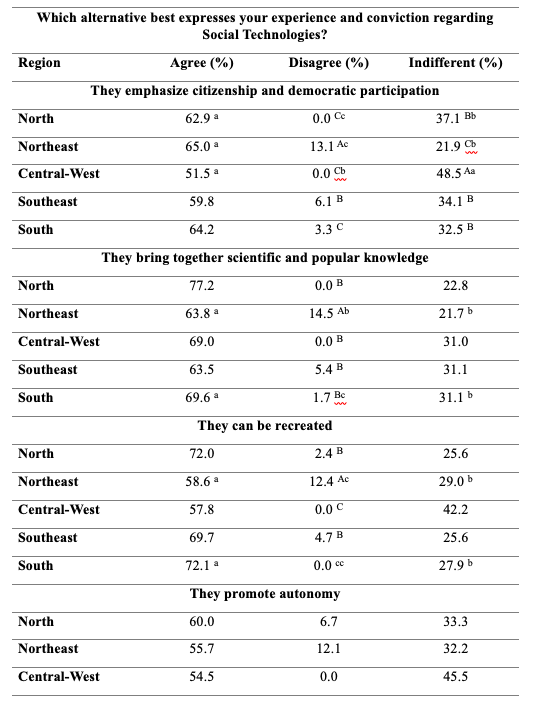
NoteLines with different lowercase letters differed significantly (p < 0.05); columns with different capital letters differed significantly (p < 0.05).
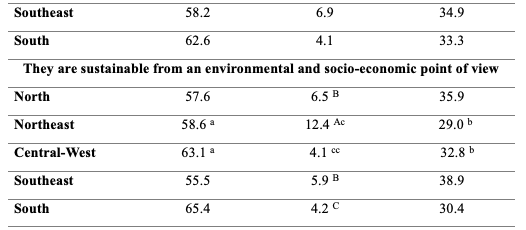
Source: Own elaboration.
Discussion
We can see that there were significant differences in the perception of extension workers within and between regions, especially in relation to those who agree that they are advanced technologies (North and Northeast) and those who think they are indifferent (Central-West and Southeast). However, regarding competitiveness, although there were no significant differences, the majority believed that they are competitive technologies. For a social technology to be considered advanced and competitive, it needs to demonstrate effectiveness in addressing the challenges faced by rural communities. In this regard, Sousa et al. (2017), who mapped social technologies for coping with the Semi-Arid region in rural communities of Cariri in the southern state of Ceará, recognized that the application of the studied social technologies was able to transform the social reality of the Cariri region. When discussing competitiveness, we also need to include the fact that the technologies need to help increase the productivity of the farmer’s end activity, as this is not the case, then a productivity is one of the essential factors for food security, income generation, and the promotion of sustainable development in rural communities, and this research solicited the perception of extensionists by stating that the introduction of social technology in rural areas contributes to increased agricultural productivity. This assertion was corroborated by extension workers in the North, Northeast, and Central-West, whereas they were indifferent in the South and Southeast. However, in order to become competitive, small farmers often need to work together, for example, by forming cooperatives (Abrol, 2011). It is understandable that there is no unanimity when discussing productivity and profitability in the context of family farming, since there are theoretical discussions in Brazil about family farming and peasantry. Schneider (2009) points out that while peasants represent a way of life, family farmers are highly integrated into the market. However, Schneider (2009) pointed out that this distinction has generated several controversies. On the one hand, some interpret the suggested metamorphosis from peasantry to family farming as an indistinct association between family farming and capitalism (or agribusiness) and, on the other words, those who envision the reduction of any and all forms of family production to peasant status. That is, such theoretical currents are also intrinsic to our extensionists.
Much is currently being discussed and invested in innovation in the countryside, but we need to understand that innovation does not have to be a highly advanced and technological product; often, the simple can result in positive changes in the work of family farmers. Another important aspect of innovation is the so-called social innovation. According to Bosworth et al. (2016), investment in social innovation is needed to have a clearer understanding of social innovation in a rural development context, identifying different processes and outcomes that create social value. This is also corroborated by Golovina et al. (2022), who state that options are needed to apply social and technological innovations to “revitalize” underdeveloped rural areas to achieve integrated development of rural areas adjacent to urban centers. From the point of view of extension workers in Brazil, the results presented in the interviews on innovation were similar to those found in the productivity item. However, despite differences between and within regions, the majority believe that they are innovative, corroborating with Yin et al. (2022), as noted the perception of whether social technologies are innovative, most extensionists understand that they are, however, despite the growing demand and initiatives for rural revitalization, rural innovation has received little attention in the literature.
No significant differences were observed on the issue of promoting only economic growth, in which the majority disagreed with this statement, i.e., the extension workers believe that in addition to promoting economic growth, they promote other types of growth, which was not detailed in the survey. Regarding the transfer of technology, we noticed a disagreement between the extension workers, with the North and Central-West regions agreeing and the Southeast disagreeing. This disagreement is probably due to historical issues, because the development of rural extension in Brazil is separated into phases, one of which is the technological packages and technology transfer - Diffusionism Phase between 1964 and 1979 (Mexpar, 2006, p. 15). The methodology of technological packages was questioned, as Caporal (2006) points out, because in this phase of diffusionism, farmers were seen as mere repositories of knowledge and packages generated by research, most of which were unsuitable for the specific conditions of their farms and the agro-ecosystems they managed. Regardless of the theoretical differences between the extensions, knowledge of new technologies is required to reach family farmers. Borges et al. (2015), in their analysis of the program created by the Brazilian Agricultural Research Corporation, known as “Balde Cheio”, found it can serve as a vector for training small dairy farm management through technology transfer. They determined that the lack of training among producers (an internal weakness in the production environment) and limited access to official credit programs (an external threat to the production environment) were some of the difficulties faced in technology transfer. Souza and Pozzebon (2020), considering the relevance of social technologies for transforming disadvantaged social scenarios, describe that valuing tacit knowledge, jointly constructing new perspectives, appealing to a sense of belonging, reclaiming social roles, and changing perceptions of local reality are key mechanisms that need to be put into practice for a social technology to promote desired local social transformations. It is important to remember that social technologies should not be seen solely as a process of technology transfer from a ready-made package of ideas, but rather as technologies created or modified from the initial package and implemented while respecting the local reality and the knowledge of those who will execute it.
Social technology that is simple, fast, and easy to implement may be advantageous in certain contexts and circumstances, but it is not necessarily the best option in all situations. Despite not showing significant differences between and within regions, most extensionists believe that social technologies should be simple. The choice between a social technology that is simple, fast, and easy to implement or one that takes a more gradual approach should be based on the specific needs of the community, available resources, and the nature of the problem to be addressed. It is important to remember that the high investment in social technology can be a significant barrier to its implementation. As observed by Ofuoku et al. (2008), the low adoption of the use of technologies was attributed not only to the cost of the technologies but also to their complexities and lack of contact with the extensionist. This agrees with the results, in which the disagreement option showed a statistical difference between and within regions, in that extensionists do not agree that social technologies require high investment. This is especially true in contexts with limited financial resources, as it not only involves the initial implementation but also the maintenance of the social technology on the property, leading to a high dependence on external financing and the associated risks that producers may not be willing to take. To avoid this problem, Medeiros et al. (2017) describe that social technologies are created and developed to solve problems of producers or rural communities, and therefore, their members should participate in their development, making social technologies the collective result of all the actors involved. The results also show that the extension workers believe that the participation of the actors involved in the process is important, and disagree that the social technology should be chosen by the extension worker.
The success of social technologies depends on a participatory approach that involves the beneficiary communities from planning to implementation (Sousa et al., 2017), fact also observed by Du Toit (2002) in the Zimbabwean pilot project, and such solutions should be adapted to local needs, considering the cultural, environmental, and socioeconomic particularities of each region (Lobo et al., 2013). Curado et al. (2014) describe the process of systematizing experiences of family farmers through a methodology based on technical visit reports, workshops on experience systematization, memories, and visual records, which brought together narratives from farmers involved in the process and contributed to strengthening the collaboration among all actors involved in the process. According to Olkhovikov et al. (2020), social technologies invent and re-discover human properties and overlooked abilities that could bring unprecedented social advantages. However, it is important to highlight that despite sociodemographic differences, according to Spurk et al. (2023), sociodemographic and economic factors, by contrast, play hardly any role, as do individual information sources.
Another determining point when discussing social technologies is their relationship with agroecology or with the agroecological transition in the production systems in which family farmers are involved. It can be seen that the extensions believe in this positive relationship, as all regions significantly disagreed that social technologies are incompatible with agroecology, corroborating Khadse et al. (2018) who understand that peasant movements scale up agroecology. Social technologies can play a fundamental role in promoting social inclusion and improving the living conditions of rural communities. They should be designed and implemented with the specific goal of addressing social, economic, and environmental challenges, focusing on the well-being and empowerment of people.
The participation of the farmer in this process, according to the opinion of the extension workers, reinforces the understanding of democracy, of feeling heard, in addition to the same understanding regarding the exchange of knowledge, between scientific and popular knowledge, which is important throughout this process. Costa Braulio et al. (2023) found that family farmers understand that popular knowledge linked to scientific knowledge is important. According to Mazzocchi (2006) traditional knowledge embodies a wealth of wisdom and experience of nature gained over millennia from direct observations, and transmitted, most often orally, over generations. This traditional knowledge is very important for the protection of biodiversity and sustainable development (Gadgil et al., 1993).
Another important point to discuss about social technologies is their ability to be easily replicated is a desirable characteristic for many social technologies used in rural areas, but it is not an absolute requirement. Easy replication of a social technology means that it can be reproduced in other rural communities, even if they differ in terms of context, available resources, and specific challenges. Sousa et al. (2017) point out that the replication of a social technology results from the mastery of that technology by rural communities. However, Duque and Valadão (2017) question the term “replication” because, according to the authors, this would only be possible with an exact copy without changes, and since the actors involved in the social process modify its content according to their needs, there would be no possibility of replicating a social technology. They believe that the term “reapplication” would be more appropriate, as reapplication involves the production and reproduction of technologies based on the specific dynamics and logics of the communities involved with these technologies. When technology is easily replicated, it will also promote the autonomy of the producer, a fact corroborated by most extension workers, with no differences between them.
The sustainability of rural social technologies is crucial for preserving the environment, promoting social inclusion, driving economic development, and improving the quality of life of rural communities. Another important factor is that social technologies can collaborate in rural entrepreneurship. According to Clausen (2020), it is necessary to develop actions to guide new research on spatial/rural entrepreneurship. However, Fatima Ferreiro et al. (2023) emphasize that it is necessary to open the ‘black box’ of social innovation and understand the concrete modes of its emergence and development. The search for solutions that are socially just, economically viable, and environmentally responsible is essential for sustainable and equitable rural development. Abrantes et al. (2018) evaluated the sociotechnical dynamics of productive backyards through the “Quintais para a Vida” (Backyards for Life) project and sought to identify environmental and socioeconomic changes in the families served. They found that in the environmental dimension, the ecological profile through agroecological practices showed greater conservation of environmental resources, improved biodiversity and soil fertility, and reduced the use of external inputs. The importance of social technologies in sustainable development was also verified by Machado and La Rovere (2018), who stated that social technologies have been promoting the sustainability of the Brazilian Semiarid region and can have a long-lasting impact if extensively applied. In the socioeconomic dimension, the same authors reported a positive influence of the project on surplus production in the researched backyards, leading to increased commercialization and income of farmers. Brazil still has a long and arduous road ahead to achieve full rural development. However, as presented by Rey-Alvite and Fernandez-Crehuet (2021), even in developed countries such as Europe, rural development remains a challenge. The author states that the European Union has a long way to go before reaching a state of rural development. Investment in the area of rural extension, especially in the use and techniques of social technologies, is necessary, however, the challenge in Brazil is great because of the size of its geographical area and its cultural and climatic particularities. The importance of investment in rural extension was also verified by Mapila et al. (2012) suggested that local agricultural extension officers should receive more capacity building and budgetary support to ensure proper understanding of agricultural innovation systems concepts and correct application to sustain their positive effects.
In a holistic view, despite statistical differences between and within regions, most extension workers in Brazil have a similar understanding that the observed differences clearly involve cultural and climatic aspects, as the regions in Brazil involve different biomes, such as Caatinga, Cerrado, Pampa, Pantanal, Atlantic rainforest, and Amazon rainforest, in addition to the economic power observed in each region. This perception is corroborated by Hardy (2019), who stated that social technologies need to be designed and understood from the perspective of different geographies and identities, however, autonomy in rural areas refers to the ability of rural communities, and the individuals living in them, to make decisions and act independently in various aspects of their lives including economic, social, political, and cultural.
Funding details
This work was supported by the CNPq - Brazil - National Council for Scientific and Technological Development - under scholarship.
Declaration of interest statement
No potential conflict of interest was reported by the authors.
Conclusions
The research revealed that rural extensionists understand that social technologies are important tools to assist in rural development, and that extensionists, regardless of the region, have a similar mindset regarding social technologies. However, knowledge is still considered low in view of the importance of the subject.
Acknowledgments
We appreciate the partnership between the Institute of Agricultural Sciences (ICA/UFVJM) and the Department of Agribusiness at California State University - FresnoState.
References
Abrantes, K. K. de J., Paula, L. A. M. de, Esmeraldo, G. G. L., Araujo, J. A. & Monte, F. C. D. (2018). Tecnologia social quintal produtivo: uma estratégia para o desenvolvimento rural sustentável. Revista Econômica Do Nordeste, 46(4), 61-77. https://doi.org/10.61673/ren.2015.604
Abrol, D. (2004). Lessons from the Design of Innovation Systems for Rural Industrial Clusters in India. Asian Journal of Technology Innovation, 12(2), 67-97. https://doi.org/10.1080/19761597.2004.9668599
Borges, M. S., Guedes, C. A. M. & E Castro, M. C. D. (2015). A Gestão do empreendimento rural: um estudo a partir de um programa de transferência de tecnologia a pequenos produtores. Revista de Ciências Da Administração, 1(1), 141-156. https://doi.org/10.5007/2175-8077.2015v17n43p141
Bosworth, G., Rizzo, F., Marquardt, D., Strijker, D., Haartsen, T. & Aagaard Thuesen, A. (2016). Identifying Social Innovations in European Local Rural Development Initiatives. Innovation: The European Journal of Social Science Research, 29(4), 442-461. https://doi.org/10.1080/13511610.2016.1176555
Presidência da República de Brasil. (2010). Lei n. 12.188, de 11 de janeiro de 2010. Institui a Política Nacional de Assistência Técnica e Extensão Rural para a Agricultura Familiar e Reforma Agrária - PNATER e o Programa Nacional de Assistência Técnica e Extensão Rural na Agricultura Familiar e na Reforma Agrária - PRONATER, altera a Lei no 8.666, de 21 de junho de 1993, e dá outras providências. Author. http://www.planalto.gov.br/ccivil_03/_ato2007-2010/2010/lei/l12188.htm
Caporal, F. & Ramos, L. (2006). Da extensão rural convencional à extensão rural para o desenvolvimento sustentável: enfrentar desafios para romper a inércia. Nova Assistência Técnica e Extensão Rural. Agroecologia. https://agroecologia.pbworks.com/f/Artigo-Caporal-Ladjane-Vers%C3%A3oFinal-ParaCircular-27-09-06.pdf
Carvalho, E. da S. & Lago, S. M. S. (2020). Tecnologia social no contexto da agricultura familiar: análise da reaplicação no território Cantuquiriguaçu - Paraná. Extensão Rural, 27(3), 84-105. https://doi.org/10.5902/2318179638505
Clausen, T. H. (2020). The Liability of Rurality and New Venture Viability. Journal of Rural Studies, 73, 114-121. https://doi.org/10.1016/j.jrurstud.2019.12.005
Dagnino, R. (2014). Tecnologia Social: contribuições conceituais e metodológicas. EDUEPB. https://doi.org/10.7476/9788578793272
De Castro Bráulio, R., Redin, E., Pereira, A. A., Mota, D. A. & Melo, V. (2023). Ethno-Zootechnics from the Perspective of Dairy Farmers in the Brazilian Cerrado. Revista de Ciencias Agroveterinarias, 22(1), 155-162. https://doi.org/10.5965/223811712212023155
De Fátima Ferreiro, M., Sousa, C., Sheikh, F. A. & Novikova, M. (2023). Social Innovation and Rural Territories: Exploring Invisible Contexts and Actors in Portugal and India. Journal of Rural Studies, 99, 204-212. https://doi.org/10.1016/j.jrurstud.2021.04.013
Diniz, R. F. & Hespanhol, A. N. (2019). Reestruturação, reorientação e renovação do serviço extensionista no Brasil: a (difícil) implementação da Política Nacional de Assistência Técnica e Extensão Rural (PNATER). Extensão Rural, 25(2), 7-30. https://doi.org/10.5902/2318179633174
Du Toit, A. (2002). Globalizing Ethics: Social Technologies of Private Regulation and the South African Wine Industry. Journal of Agrarian Change, 2(3), 356-380. https://doi.org/10.1111/1471-0366.00038
Duque, T. O. & Valadão, J. de A. D. (2017). Abordagens teóricas de tecnologia social no Brasil. Revista Pensamento Contemporâneo Em Administração, 11(5), 1-19. https://doi.org/10.12712/rpca.v11i5.962
Fleury Curado, F., Da Silva dos Santos, A. & De Jesus Oliveira, M. (2014). Sistematização de experiências agroecológicas no território Semiárido Nordeste. Cadernos de Ciência & Tecnologia, 31(2), 349-380. https://ainfo.cnptia.embrapa.br/digital/bitstream/item/128102/1/Sistematizacao-de-expriencas-agroecologicas.pdf
Gadgil, M., Berkes, F. & Folke, C. (1993). Indigenous Knowledge for Biodiversity Conservation. Ambio, 22(2-3). https://www.jstor.org/stable/4314060
Golovina, S., Ruchkin, A. & Mikolaychik, I. (2022). European Experience in Rural Areas Supporting: Recommendations for Implementation in Russian Practice. Agrarian Bulletin of The, 217(2), 71-81. https://doi.org/10.32417/1997-4868-2022-217-02-71-81
Hardy, J. (2019). How the Design of Social Technology Fails Rural America. Companion Publication of the 2019 on Designing Interactive Systems Conference 2019 Companion, 189-193. https://doi.org/10.1145/3301019.3323906
Instituto Brasileiro de Geografia e Estatística (IBGE). (2019). Censo agropecuário 2017. Censo Agropecuário.
Khadse, A., Rosset, P. M., Morales, H. & Ferguson, B. G. (2018). Taking Agroecology to Scale: The Zero Budget Natural Farming peasant movement in Karnataka, India. Journal of Peasant Studies, 45(1), 192-219. https://doi.org/10.1080/03066150.2016.1276450
Lobo, M. A. A., Lima, D. M. B. de, Souza, C. M. N., Nascimento, W. A., Araújo, L. C. C. & Santos, N. B. dos. (2013). Avaliação econômica de tecnologias sociais aplicadas à promoção de saúde: abastecimento de água por sistema Sodis em comunidades ribeirinhas da Amazônia. Ciência & Saúde Coletiva, 18(7), 2119-2127. https://doi.org/10.1590/S1413-81232013000700027
Machado, L. & Rovere, E. (2017). The Traditional Technological Approach and Social Technologies in the Brazilian Semiarid Region. Sustainability, 10(2), 25. https://doi.org/10.3390/su10010025
Mapila, M. A. T. J., Kirsten, J. F. & Meyer, F. (2012). The Impact of Agricultural Innovation System Interventions on Rural Livelihoods in Malawi. Development Southern Africa, 29(2), 303-315. https://doi.org/10.1080/0376835X.2012.675699
Martinez Guerra, G. C. & Ichikawa, E. Y. (2013). As representações sociais da agroecologia para a agricultura familiar: a visão de pesquisadores, extensionistas e produtores rurais. Desenvolvimento Em Questão, 11(23), 40-73. https://doi.org/10.21527/2237-6453.2013.23.40-73
Mazzocchi, F. (2006). Western Science and Traditional Knowledge: Despite their Variations, Different Forms of Knowledge Can Learn from Each Other. EMBO Reports, 7(5), 463-466. https://doi.org/10.1038/sj.embor.7400693
Medeiros, C. B. de, Galvão, C. E. de S., Correia, S., Gómez, C. & Castillo, L. (2017). Inovação social além da tecnologia social: constructos em discussão. RACE - Revista de Administração, Contabilidade e Economia, 16(3), 957-982. https://doi.org/10.18593/race.v16i3.13606
MEXPAR. (2006). Metodologias participativas de extensão rural para o desenvolvimento sustentável. EMATER, MG.
Nunes, E. M., Tôrres, F. de L., Silva, M. R. F. da, Sá, V. C. de & Godeiro-Nunes, K. F. (2015). Dinamização econômica e agricultura familiar: limites e desafios do apoio a Projetos de Infraestrutura (Proinf) em territórios rurais do Nordeste. Revista de Economia e Sociologia Rural, 53(3), 529-554. https://doi.org/10.1590/1234-56781806-9479005303009
Ofuoku, A. U., Olele, N. F. & Emah, G. N. (2008). Determinants of Adoption of Improved Fish Production Technologies among Fish Farmers in Delta State, Nigeria. The Journal of Agricultural Education and Extension, 14(4), 297-306. https://doi.org/10.1080/13892240802416186
Olkhovikov, K., Olkhovikova, S., Zhuravleva, L., Kant Ojha, N., Elena, Z. & Ruchkin, A. (2020). Environmental Turn in Running the Rural Territories: New Social Technologies of Administration. E3S Web of Conferences, 176, 1-8. https://doi.org/10.1051/e3sconf/202017605001
Passoni, I., Barroso, E. A. S., Oliveira, G. J. L., Guimarães, F. C. S., Silva, P. H. U., Jardim, F. A. A. & Otero, M. R. (2004). Caderno de Debate: Tecnologia Social no Brasil. Instituto de Tecnologia Social (I. T. S. Brasil). https://drive.google.com/file/d/1pSB4DlxqDIiBL15M3epNToby-yDnQ5Xo/view?usp=drive_link
Rey-Alvite, A. & Fernández-Crehuet, J. M. (2021). Smart Rural: Current Status of the Intelligent, Technological, Social and Sustainable Rural Development in the European Union. Innovation: The European Journal of Social Science Research, 34(2), 136-158. https://doi.org/10.1080/13511610.2020.1760798
Schneider, S. (Org.). (2009). A diversidade da Agricultura Familiar. Editora da UFRGS.
Simões, A. R. P., Oliveira, M. V. M. de & Lima-Filho, D. de O. (2015). Tecnologias sociais para o desenvolvimento da pecuária leiteira no Assentamento Rural Rio Feio em Guia Lopes da Laguna, MS, Brasil. Interações (Campo Grande), 16(1), 163-173. https://doi.org/10.1590/1518-70122015114
Sousa, A. B. de, Costa, C. T. F. da, Firmino, P. R. A. & Batista, V. de S. (2017). Tecnologias sociais de convivência com o semiárido na região do cariri cearense. Cadernos de Ciência & Tecnologia, 34(2), 197-220. http://dx.doi.org/10.35977/0104-1096.cct2017.v34.26327
Souza, A. C. A. A. de & Pozzebon, M. (2020). Práticas e mecanismos de uma tecnologia social: proposição de um modelo a partir de uma experiência no semiárido. Organizações & Sociedade, 27(93), 231-254. https://doi.org/10.1590/1984-9270934
Souza, P. M. de, Fornazier, A., Souza, H. M. de & Ponciano, N. J. (2019). Diferenças regionais de tecnologia na agricultura familiar no Brasil. Revista de Economia e Sociologia Rural, 57(4), 594-617. https://doi.org/10.1590/1806-9479.2019.169354
Spurk, C., Koch, C., Bürgin, R., Chikopela, L., Konaté, F., Nyabuga, G., Sarpong, D. B., Sousa, F. & Fliessbach, A. (2023). Farmers’ Innovativeness and Positive Affirmation as Main Drivers of Adoption of Soil Fertility Management Practices – Evidence Across Sites in Africa. The Journal of Agricultural Education and Extension, 1-25. https://doi.org/10.1080/1389224X.2023.2281909
WorldAtlas. (2023). Articles/the Five Regions of Brazil. Author. https://www.worldatlas.com
Yin, X., Chen, J. & Li, J. (2022). Rural Innovation System: Revitalize the Countryside for a Sustainable Development. Journal of Rural Studies, 93, 471-478. https://doi.org/10.1016/j.jrurstud.2019.10.014
Notes
*
Research article.
Author notes
a Corresponding author. E-mail: thiago.melo@ufvjm.edu.br
Additional information
How to cite: Marques, V. R., Lone, T., Barbe, L. C., Pereira, A. A., Mota, D. A., Redin, E., Xu, P., Broch Siqueira, J. & Vasconcelos Melo, T. (2024). Social Technologies in the Perception of Rural Extensionists in Brazil. Cuadernos de Desarrollo Rural, 21. https://doi.org/10.11144/Javeriana.cdr21.stpr










